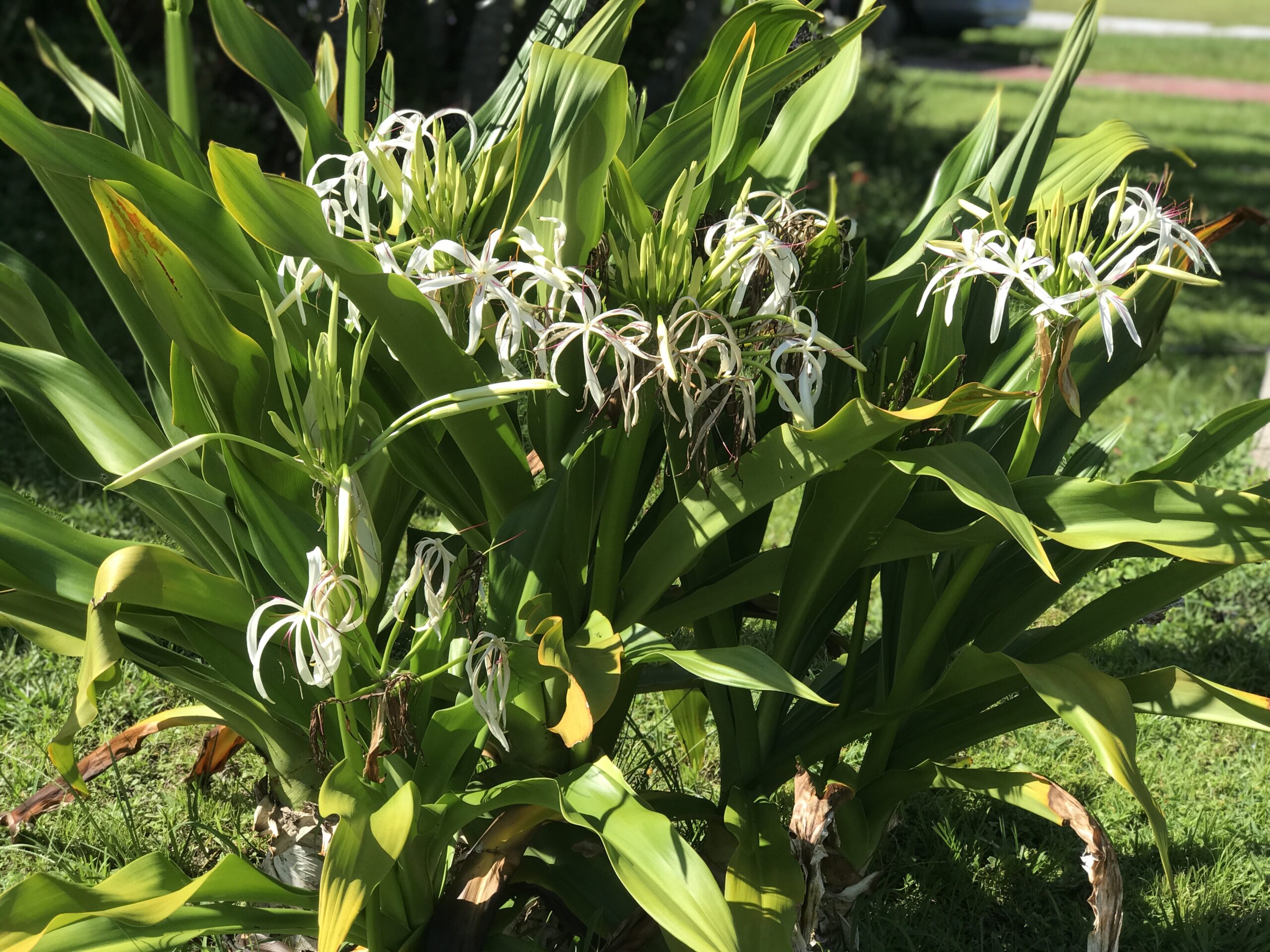
The Crinum Lily, renowned for its majestic beauty and resilience, is a captivating addition to any garden. This perennial plant boasts an array of attributes that make it both visually striking and a favorite among garden enthusiasts.
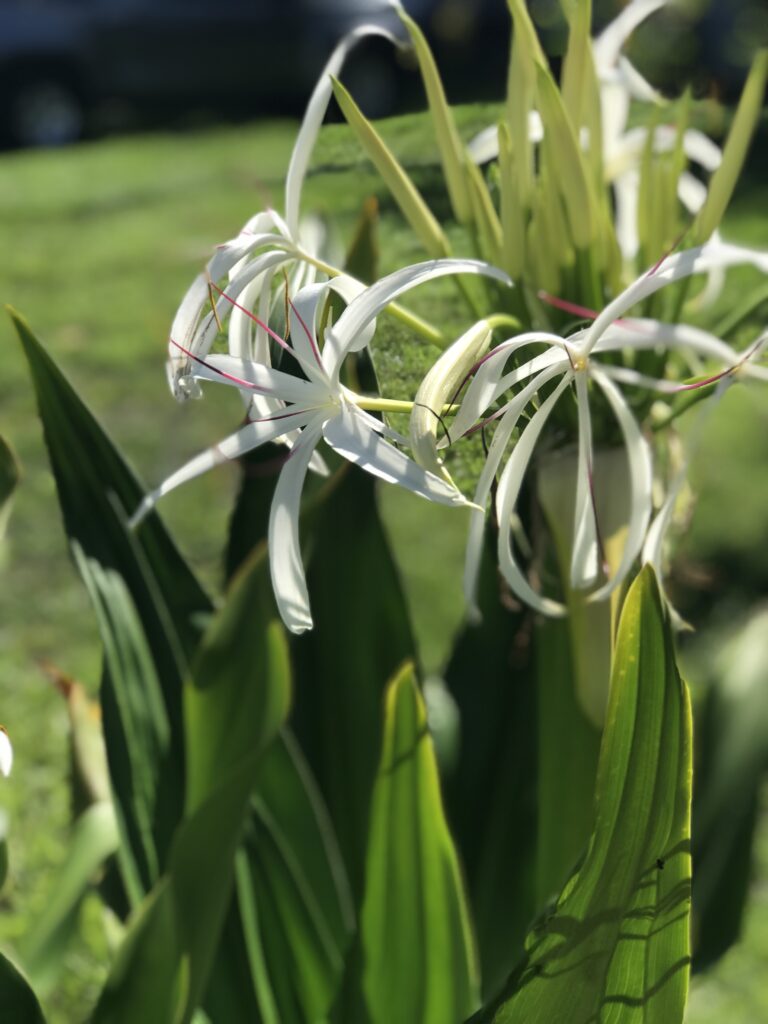
Crinum lilies, part of the Amaryllidaceae family, are characterized by their large, trumpet-shaped flowers that exude a sweet, sometimes overpowering fragrance. These blossoms come in a variety of colors, ranging from pure white to vibrant pinks and deep reds, often featuring subtle stripes or contrasting color patterns. The plant’s size is equally impressive, with some species reaching up to 5 feet in height.
The leaves of crinum lilies are another notable feature. They are long, strap-like, and can vary in color from bright green to a more muted, grayish-green hue. The leaves often form a dense rosette at the base of the plant, creating a lush and full appearance.
Crinum Lily Botanical Background
Crinum lilies are closely related to other members of the Amaryllidaceae family, such as amaryllis and narcissus. Their scientific classification places them in the genus ‘Crinum’, which comprises over 100 species.
Crinum lilies, with their diverse species, are indigenous to various parts of the world, including regions in the United States.
Native to Various Continents
Originally, crinum lilies were native to tropical and subtropical regions across Africa, Asia, and Australia. These continents host a wide array of Crinum species, each adapted to the unique environmental conditions of their habitats.
In Africa, for instance, crinums are often found in wet, marshy areas, while in Australia, they can adapt to drier, more arid conditions.
United States Native Species
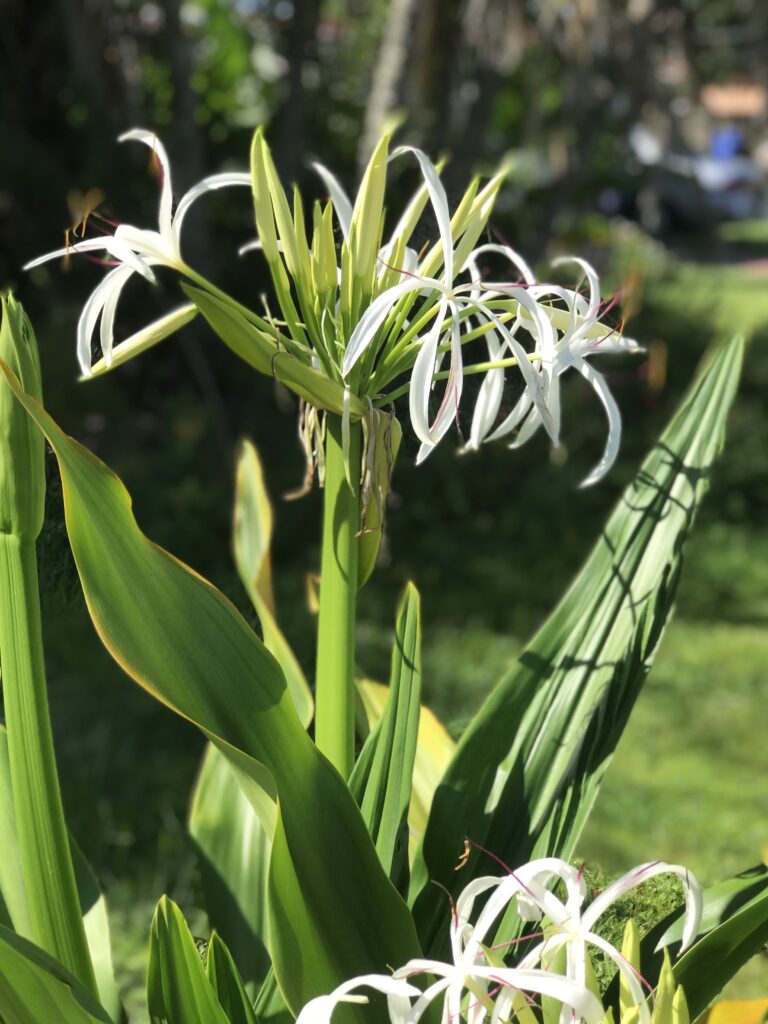
Significantly, there are species of crinum lilies that are native to the southeastern United States. Crinum americanum, commonly known as the American Crinum Lily or Swamp Lily, is a notable example.
This species is particularly adapted to the warm, humid climate of this region, flourishing in wet, marshy environments such as riverbanks and pond edges. Its white, fragrant flowers make it a popular choice for water gardens and naturalized areas.
You’ll find it flourishing in the Southeastern U.S. from North Carolina to Florida and across the Gulf Coast states as far west as Texas.
Adaptation and Naturalization
In addition to the native species, several Crinum species have been introduced and naturalized in parts of the United States, particularly in warmer regions.
For example, Crinum bulbispermum, originally from Africa, has naturalized in areas of the southern United States, especially in Texas. These naturalized species have adapted well to local conditions and are often found in cultivated gardens as well as in wild areas.
Cultivated Regions and Conditions
In terms of cultivation, crinum lilies are most successful in USDA zones 7 through 11. They thrive in full sun to partial shade and prefer well-draining soil. However, their resilience allows them to adapt to various soil types and environmental conditions, making them a versatile addition to many gardens and landscapes in these regions.
In gardens across the United States, Europe, and other temperate regions, crinum lilies are often used in borders, as focal points in flower beds, or grown as pond-side plants due to their affinity for moisture.
Their robust nature allows them to adapt to various garden settings, making them a versatile choice for landscapers and home gardeners alike.
Types of Crinum Lily
Here are just a few of the many captivating varieties of Crinum Lily. Each brings its own unique charm and character to a garden.
The diversity in their flowering colors, leaf shapes, and preferred growing conditions make Crinum lilies a versatile and attractive choice for gardeners and landscapers around the world
American Crinum Lily or Swamp Lily (Crinum americanum)
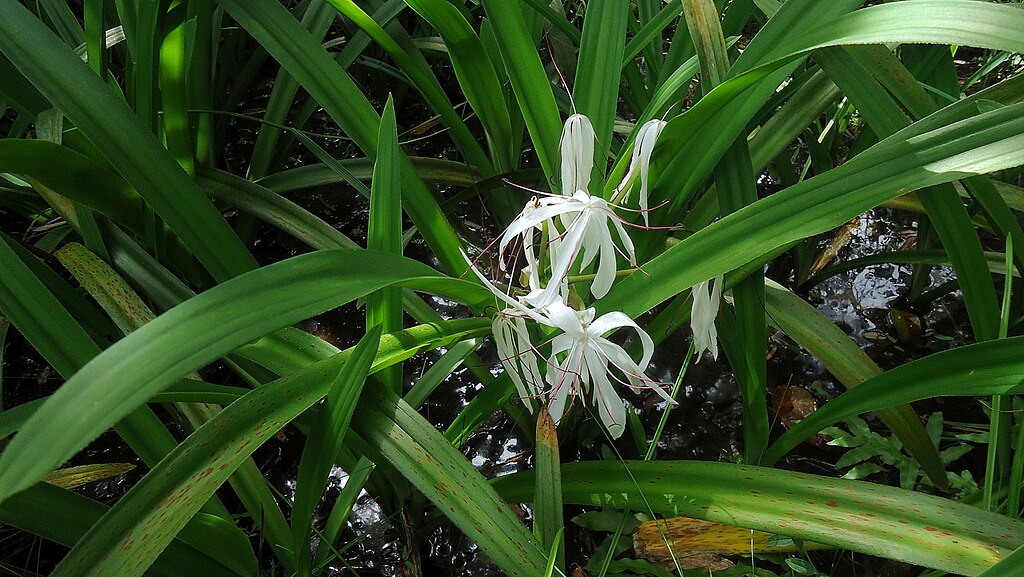
The American Crinum Lily, native to the southeastern United States, is renowned for its elegant, fragrant white flowers. It thrives in wet, marshy areas, often found along riverbanks and pond edges.
This species typically blooms in the summer and is recognized for its long, strap-like leaves that form a lush rosette.
Giant Crinum Lily (Crinum asiaticum)
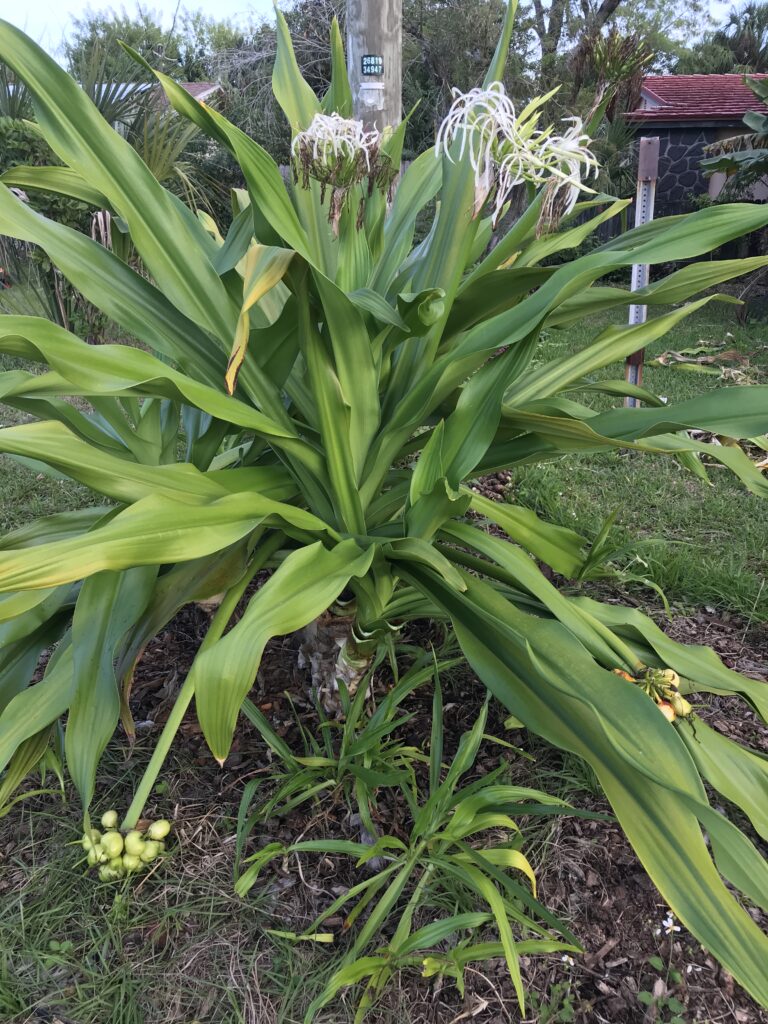
Crinum asiaticum, commonly known as the Giant Crinum Lily, is a large and robust plant. Native to tropical Asian regions, it features large clusters of white, fragrant flowers that sit atop tall stalks.
The plant can reach up to 6 feet in height, making it a striking specimen in any garden setting. It is especially popular in warmer climates and is known for its broad, glossy leaves.
Milk-and-Wine Lily (Crinum bulbispermum)

Originally from Africa, the Milk-and-Wine Lily has naturalized in parts of the southern United States. Its name comes from the distinctive coloring of its flowers – white petals with striking red or burgundy stripes.
This hardy plant can tolerate a range of conditions, from wet to dry soils, and is often found in cultivated gardens and natural areas.
Broad-Leaved Crinum (Crinum latifolium)
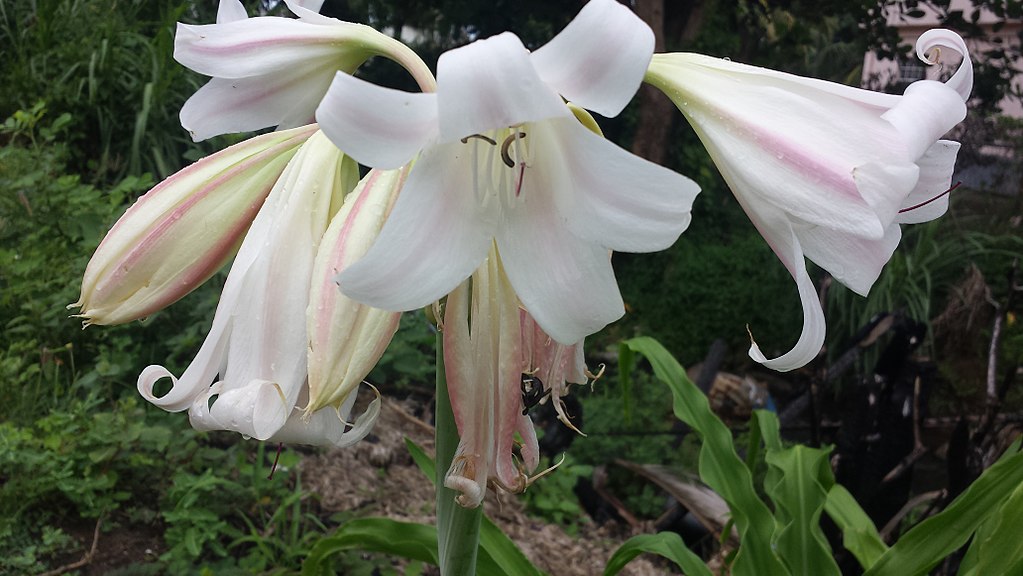
Crinum latifolium, or Broad-Leaved Crinum, is native to Southeast Asia. It’s known for its wide, dark green leaves and large clusters of pink or white flowers.
This species is often used in traditional medicine in its native regions and is also a popular ornamental plant due to its attractive foliage and flowers.
Moore’s Crinum Lily (Crinum moorei)
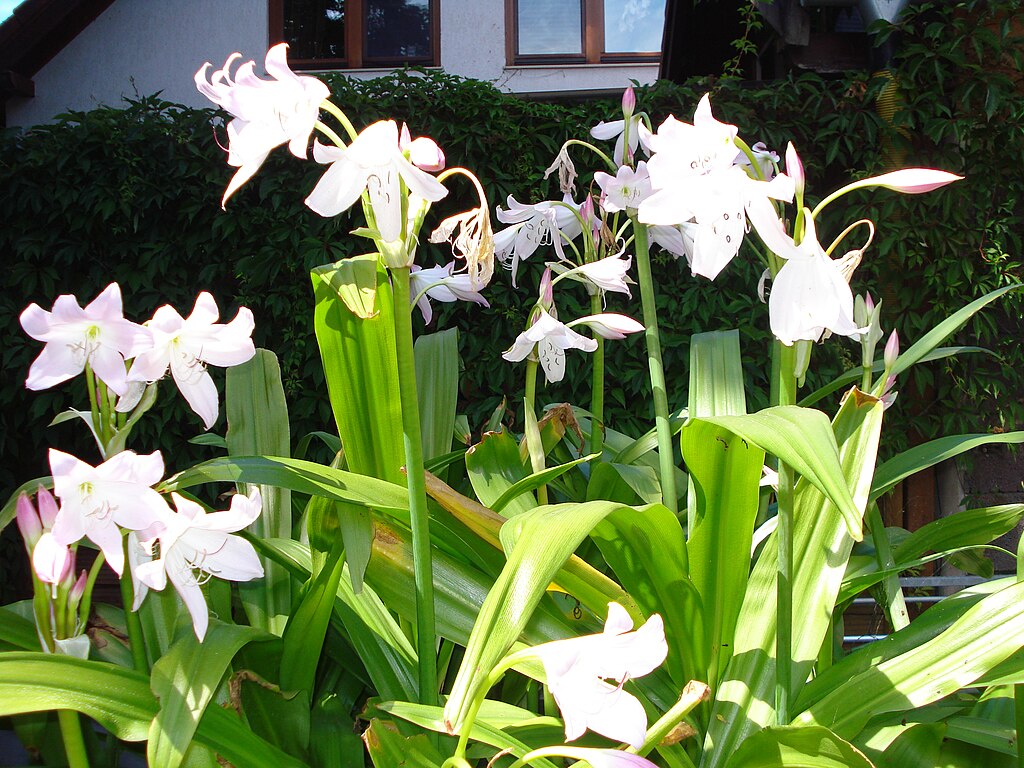
Native to South Africa, Moore’s Crinum is admired for its large, fragrant pink flowers. This species prefers shadier conditions compared to other crinums, making it suitable for planting under trees or in areas with partial sunlight.
It’s a popular choice for adding a splash of color to woodland gardens.
Powell’s Crinum Lily (Crinum x powellii)
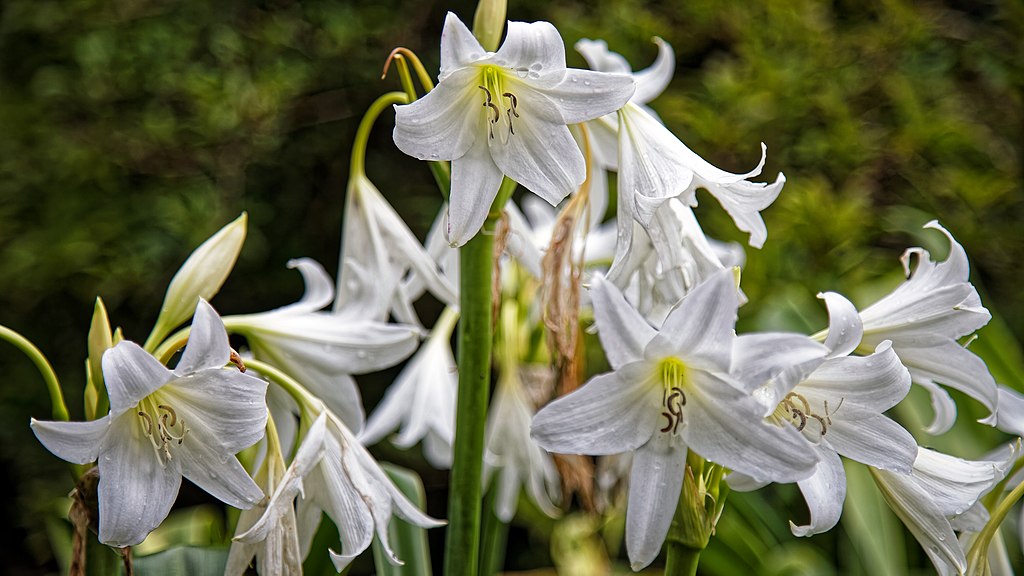
This hybrid crinum, a cross between Crinum bulbispermum and Crinum moorei, is well-loved for its robust nature and beautiful blooms. Powell’s Crinum Lily produces clusters of soft pink or white flowers and is particularly hardy, able to withstand colder temperatures better than many other crinum species.
It’s an excellent choice for a perennial border or as a statement plant in large gardens.
How To Care For Crinum Lilies
Crinum lilies, with their striking beauty and resilience, are a splendid addition to many gardens. To ensure these plants thrive and produce their large, fragrant blooms, it’s essential to understand the specifics of their care.
Where to Plant Crinum Lilies
The ideal location for planting crinum lilies is a spot where they can receive ample sunlight while being protected from harsh, direct afternoon sun in hotter climates.
These plants flourish in well-draining soil and can tolerate a variety of soil types, though they prefer a slightly acidic to neutral pH.
Crinum lilies do well in both garden beds and large containers, provided there’s enough space for their roots to spread.
When to Plant Crinum Lilies
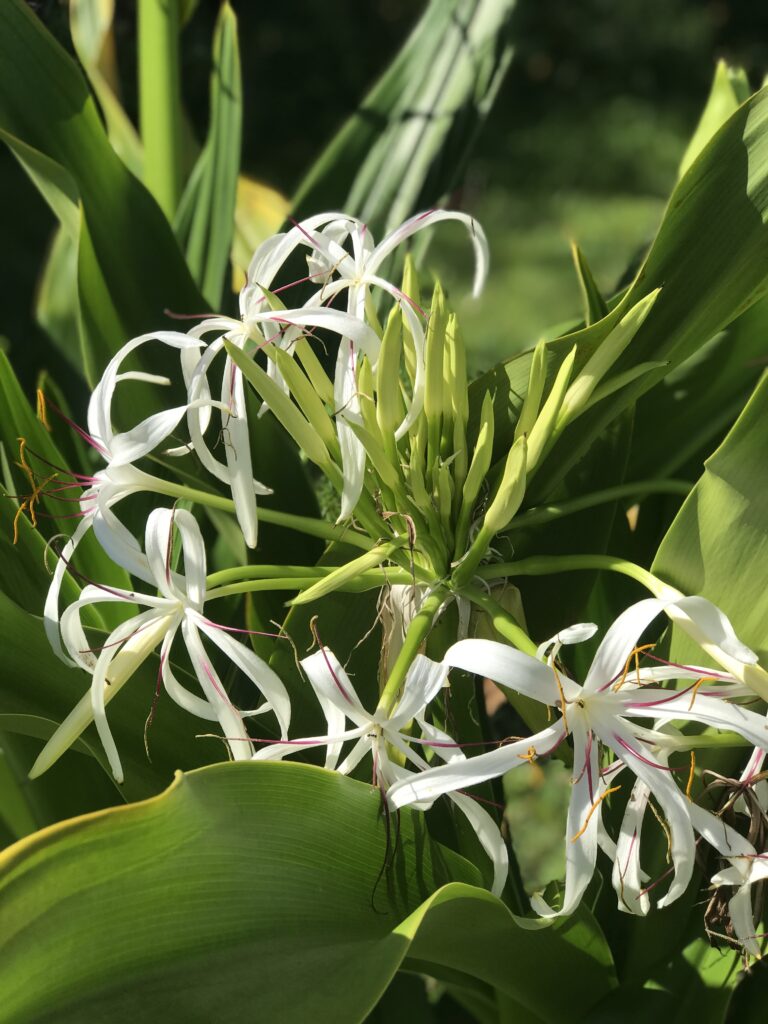
The best time to plant crinum lilies is in the spring, after the threat of frost has passed. This allows the plant ample time to establish itself before the colder months.
When planting, ensure the bulbs are placed deep enough, with the top of the bulb just below the soil surface.
Spacing is also crucial – allow about 18-24 inches between each bulb to give each plant room to grow.
Crinum Lily Care Tips
From selecting the right planting location to regular maintenance, every aspect plays an important role in adding these beauties to your landscape.
Light
Crinum lilies thrive in full sun to partial shade. They need at least 4-6 hours of sunlight daily to bloom profusely. In regions with intense sun, providing some afternoon shade can prevent leaf scorch.
Soil
While crinum lilies are adaptable to various soil types, they perform best in rich, well-drained soil. If the soil is heavy or clayey, incorporating organic matter such as compost can improve drainage and fertility.
Water
Regular watering is essential, especially during the growing season. The soil should be kept moist but not waterlogged. Overwatering or poor drainage can lead to bulb rot.
Once established, crinum lilies are quite drought-tolerant, though consistent moisture will yield the best flowering results.
Temperature
Crinum lilies enjoy warm temperatures and are most active in growth during the summer months. They can tolerate brief periods of cooler weather but are not frost-hardy.
In Zones 6 and colder, it may be best to lift the bulbs before the first frost to overwinter indoors.
Humidity
These plants typically do well in average garden humidity levels. In very dry climates, occasional misting can help maintain adequate humidity, though it’s not usually necessary.
Fertilizer
Feeding crinum lilies with a balanced, slow-release fertilizer in early spring can encourage vigorous growth and abundant flowering. A layer of compost can also improve bloom performance.
Avoid over-fertilizing, as this can lead to more foliage at the expense of flowering.
Pruning
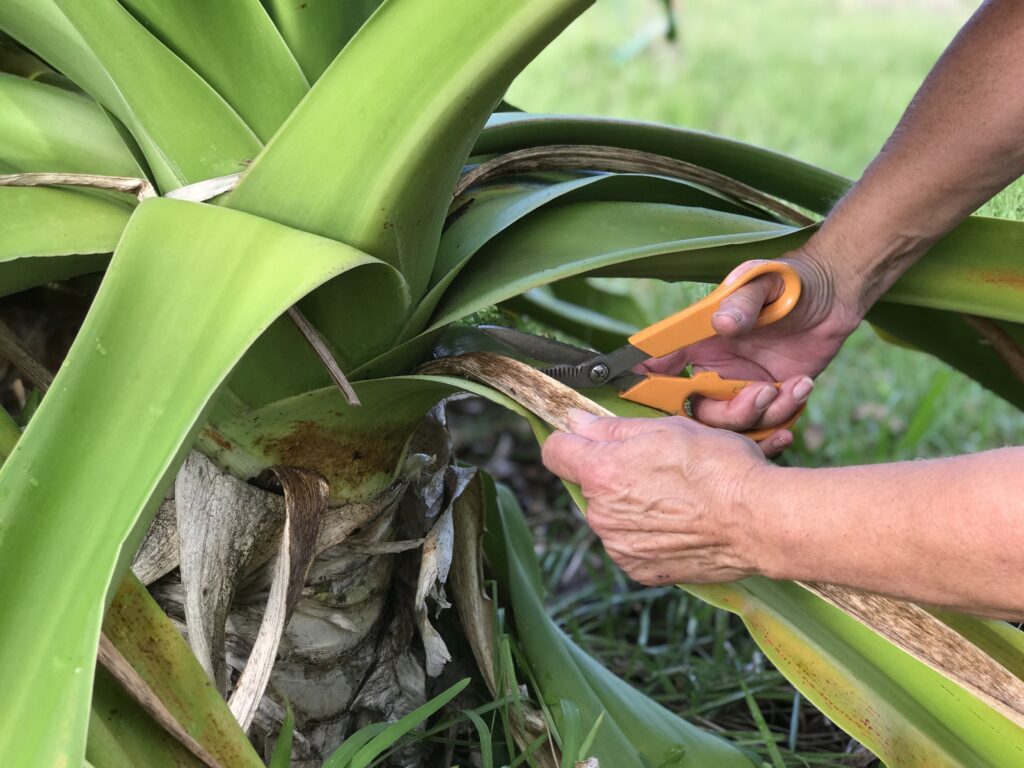
Pruning isn’t a significant requirement for crinum lilies. However, removing spent flowers and yellowing leaves can improve the plant’s appearance and health.
After flowering, it’s best to leave the foliage intact as it helps in photosynthesis, strengthening the bulb for the next season.
Caring for crinum lilies involves a blend of the right environmental conditions and attentive maintenance.
By providing these elegant plants with what they need, gardeners can enjoy their spectacular blooms and lush foliage for many years.
Overwintering Crinum Lilies
In regions where the climate turns cold and frosty, overwintering crinum lilies becomes an essential aspect of their care.
These plants, native to warmer climates, need special attention as temperatures drop. Gardeners in colder zones can still enjoy the beauty of crinum lilies by employing effective overwintering techniques, ensuring their survival through the winter months and vibrant regrowth in spring.
Potting and Repotting Crinum Lilies in Colder Climates
For gardeners in areas with harsh winters, growing crinum lilies in pots is a practical solution. This allows for the mobility of the plants, making it easier to move them indoors or to a sheltered location when the cold sets in.
When selecting a pot, ensure it is large enough to accommodate the bulb and allow for root growth, with ample drainage holes to prevent waterlogging.
Potting-Up Crinum Lily
In late fall, before the first frost, potted crinum lilies should be moved to a cool, dry place such as a garage or basement where temperatures remain above freezing but do not exceed 50°F (10°C).
This period of dormancy is crucial for the health of the plant. During this time, watering should be reduced significantly, only enough to keep the soil from completely drying out.
As spring approaches and the threat of frost diminishes, gradually reintroduce the crinum lilies to outdoor conditions.
This process, known as hardening off, involves exposing the plants to the outdoors for a few hours each day, progressively increasing the time they spend outside over a week or two. This helps the plants acclimate to the changing environment, reducing the risk of shock from sudden temperature changes.
Lifting Crinum Lily Bulbs
For crinum lilies planted in the ground in colder climates, lifting the bulbs before the first frost and storing them in a cool, dry place over the winter is an effective strategy.
The bulbs should be gently dug up, cleaned of soil, and allowed to air dry for a few days. Once dry, store them in a breathable container, like a mesh bag or a box with peat moss, in a cool, dark place until it’s time to replant them in the spring.
By potting and appropriately caring for crinum lilies during the colder months, gardeners in virtually any climate can enjoy the splendor of these beautiful plants year after year. The key is to provide a period of dormancy and protect the bulbs from the harsh winter conditions.
Common Problems with Crinum Lilies
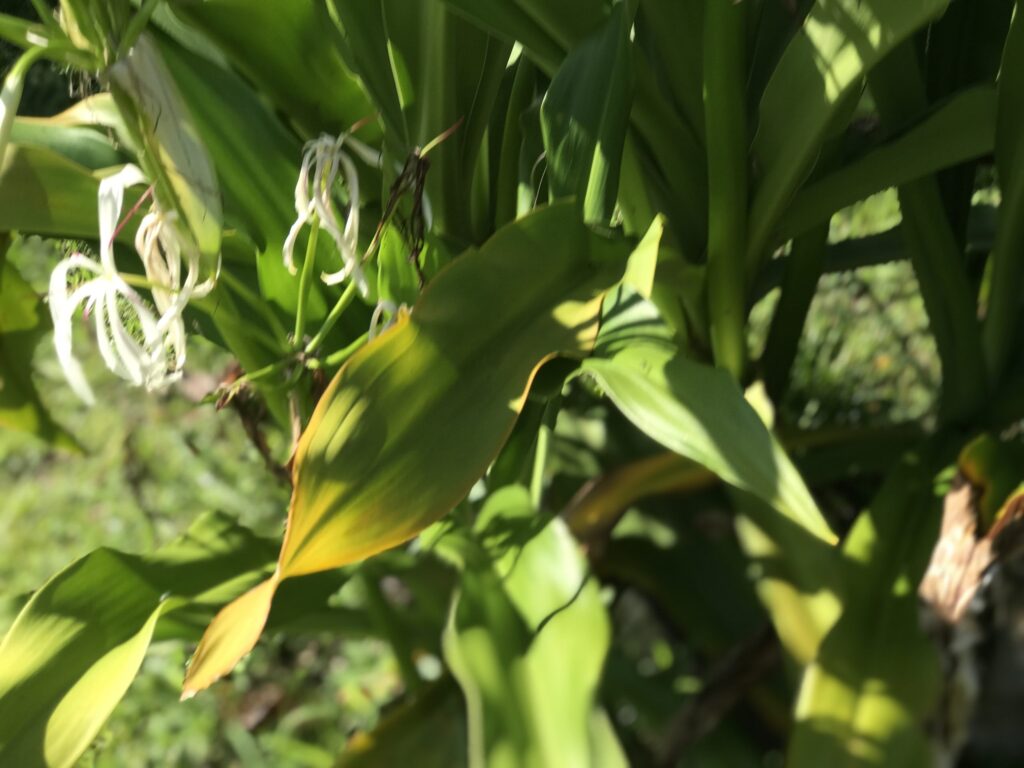
Crinum lilies, known for their robust nature and striking appearance, are generally low-maintenance plants. However, like all garden plants, they can occasionally face challenges.
Understanding and promptly addressing common problems such as pests, diseases, and other issues is key to maintaining the health and beauty of these plants.
Pests
While crinum lilies are not heavily prone to pest infestations, they can sometimes be affected by common garden pests.
Aphids, spider mites, and mealybugs are among the pests that may be attracted to these plants. These small insects can usually be found on the undersides of leaves or at the base of the plant. They feed on the sap, weakening the plant over time.
Regular inspection and prompt treatment with an insecticidal soap can effectively control these pests with diligent application.
Diseases
Crinum lilies can be susceptible to a few diseases, especially in conditions of poor air circulation or excessive moisture.
Root rot is a common issue, often caused by overwatering or poorly draining soil. Signs of root rot include yellowing leaves and a general decline in plant health. Ensuring proper soil drainage and avoiding overwatering are key preventive measures.
Fungal infections like leaf spot can also occur, usually manifesting as discolored spots on the leaves. These can be treated with organic fungicides and by removing affected foliage.
How To Get Crinum Lilies To Bloom
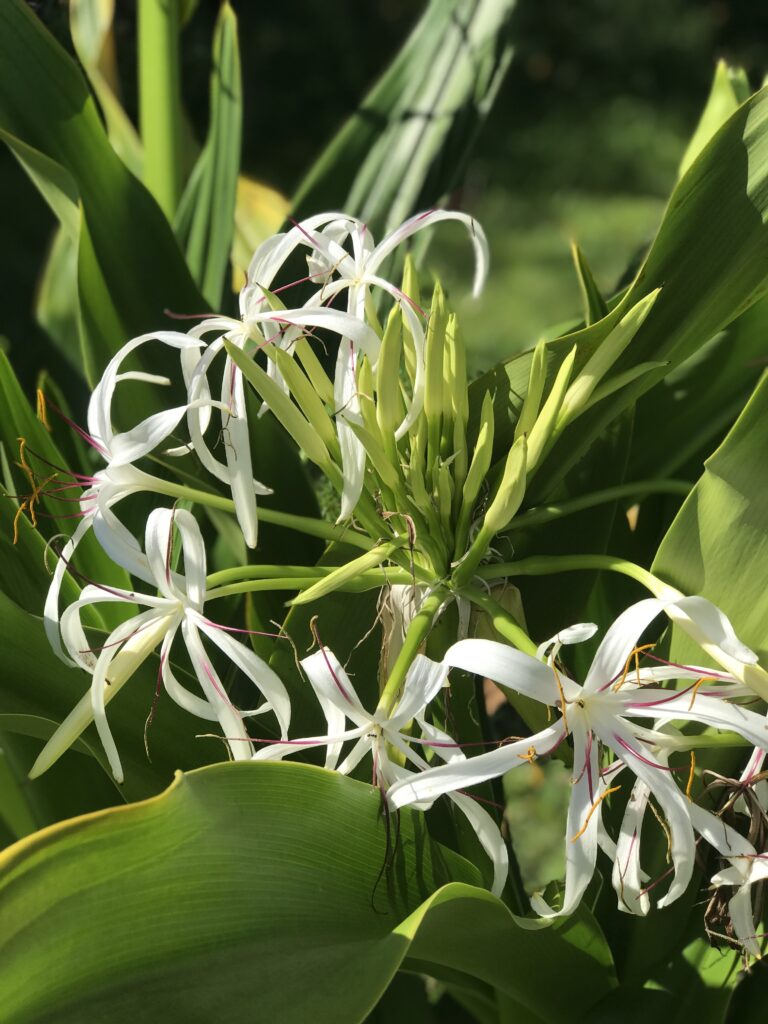
To encourage blooming in crinum lilies, several factors should be considered. Firstly, these plants need plenty of sunlight – at least 4-6 hours of direct sun per day. If they are planted in too much shade, their blooming may be sparse.
Nutrient availability is also crucial. Applying a balanced, slow-release fertilizer during the growing season can provide the necessary nutrients for blooming. Additionally, avoiding over-fertilization is important, as too much nitrogen can lead to lush foliage at the expense of flowers.
Finally, allowing the plants to establish themselves without disturbance can also enhance blooming. Mature crinum lilies, well-settled in their location, often produce the most spectacular blooms.
Propagating Crinum Lilies
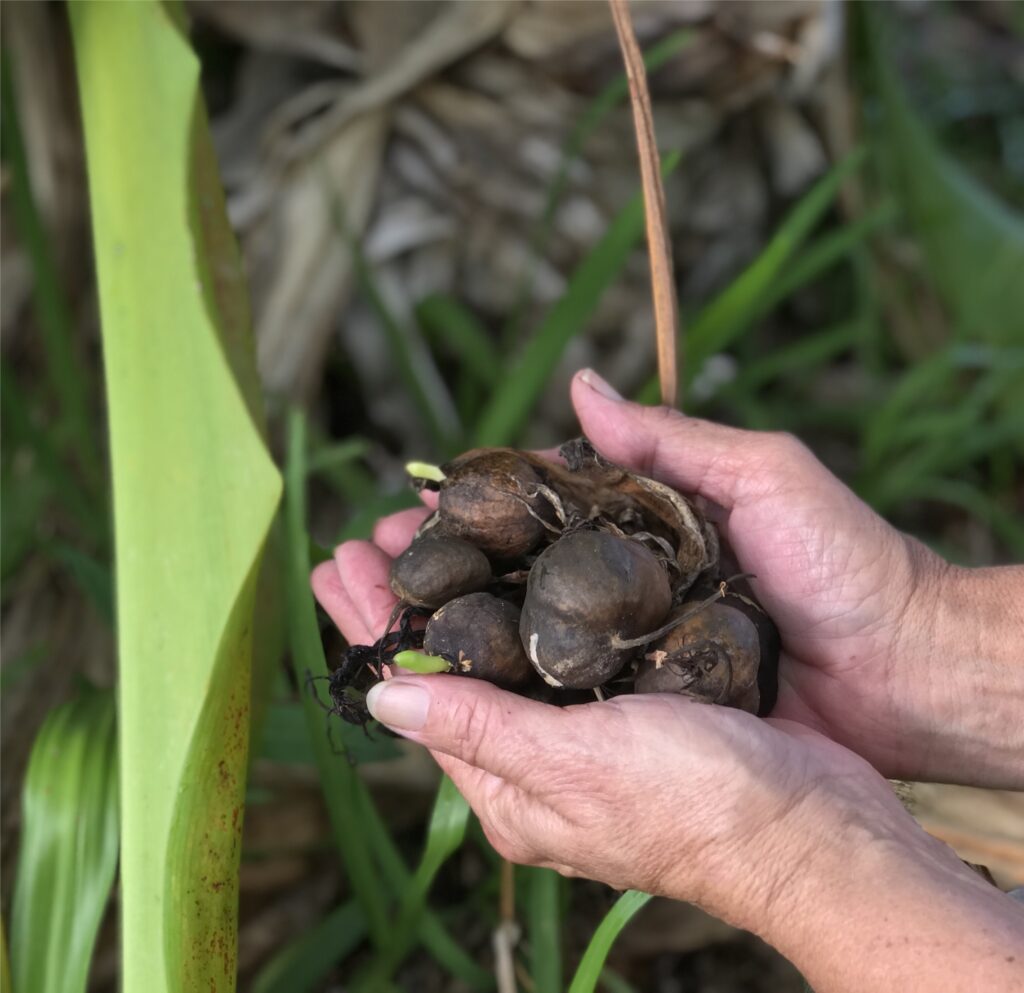
Propagating crinum lilies is a rewarding process that allows gardeners to expand their collection and share these beautiful plants with others.
One of the most effective methods of propagation for crinum lilies is through bulbils. Bulbils are small bulbs that form below the flowers on the stem.
The process is straightforward and can be accomplished with a few simple steps.
Propagate Crinum Lily from Bulbils
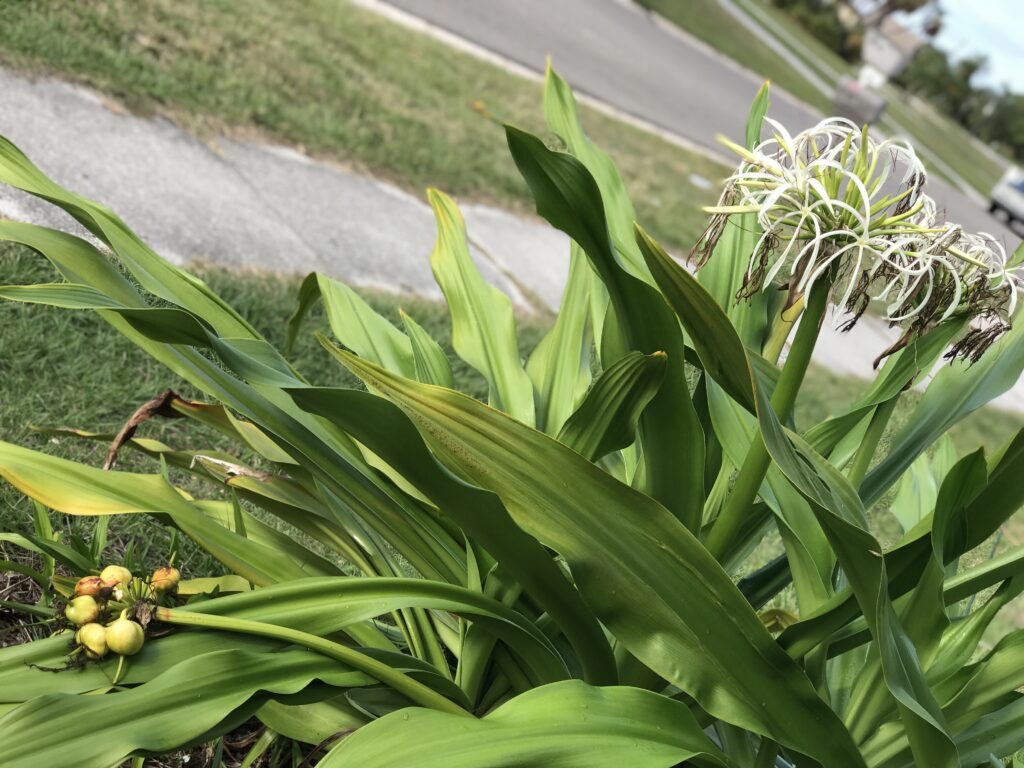
The first step is to observe the flower stems of your crinum lilies. These can grow from 3 to 6 feet tall. After flowering, bulbils will start to form at the top of these stems.
As they mature, they will grow in size and develop a firmer, more bulb-like structure. As they mature, the stem bends or flops over due to the weight of the growing bulbils, bringing them closer to the ground.
This is where they like to root. If you’re wondering if Crinum Lilies spread, this is how they do exactly that. The stems are long enough to fall just near the mother plant.
In their natural growth process, these bulbils will eventually root where they fall, often at the base of the parent plant or in surrounding soil. This natural rooting process is a unique trait of crinum lilies, allowing for easy propagation.
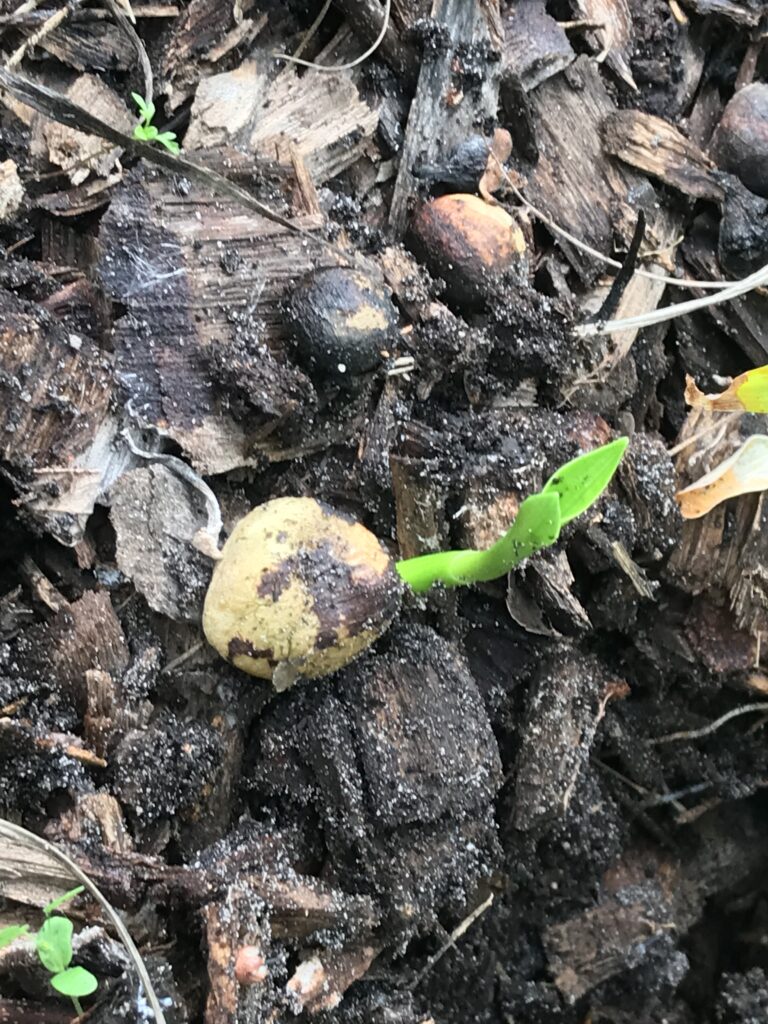
To propagate Crinum Lily, or if you wish to share them, you can collect the bulbils once they have matured. Mature bulbils are typically firm and have developed a dry, papery outer layer.
Storing Crinum Lily Bulbils
I store Crinum Lily bulbils in damp sphagnum moss or coconut coir in a large plant container. This large pot goes into the greenhouse where the lighting is low, the humidity high, and the temperature warmer in the winter.
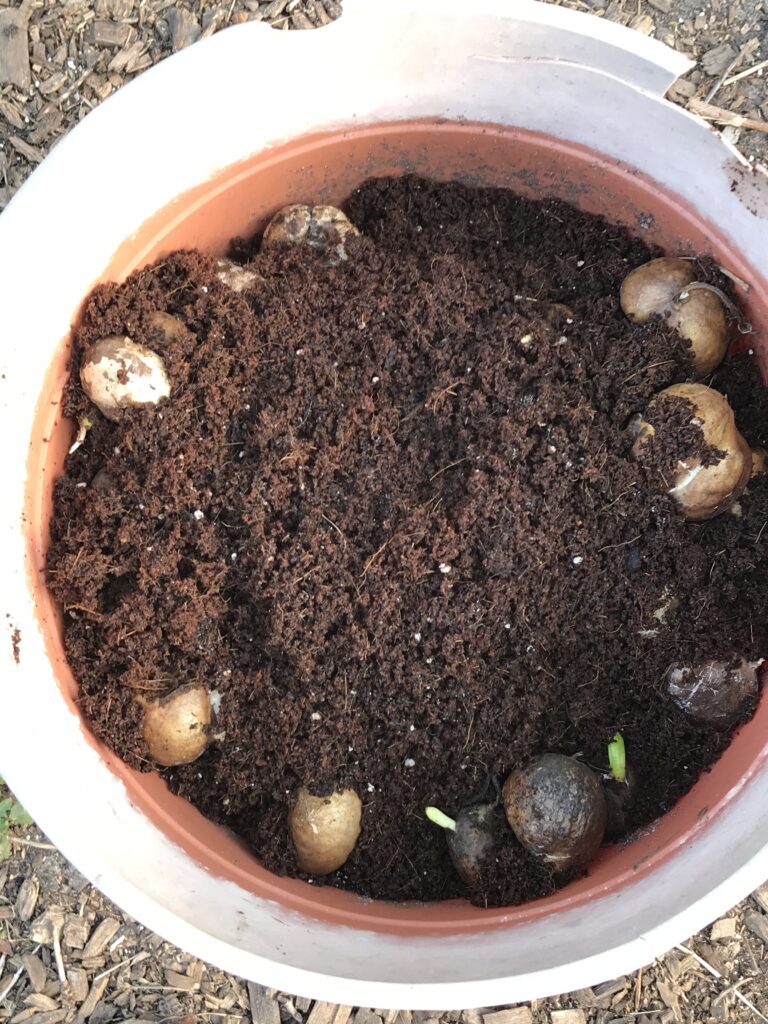
Planting the Bulbils
I generally allow the bulbils to sprout before planting, however, you can plant them at any time when the weather remains warm.
To plant them in containers, choose a well-draining soil mix for planting the collected bulbils. Plant them in pots with the top of the bulbil just below the soil surface. If they’ve already sprouted, ensure that the sprout can reach the light above the surface easily.
When planting in the ground, space them at least 12″ to 18″ apart to provide enough room for growth.
Initial Care and Growth
Water the newly planted bulbils moderately, ensuring the soil is moist but not waterlogged. Place them in a location where they receive bright, indirect light.
Transplanting
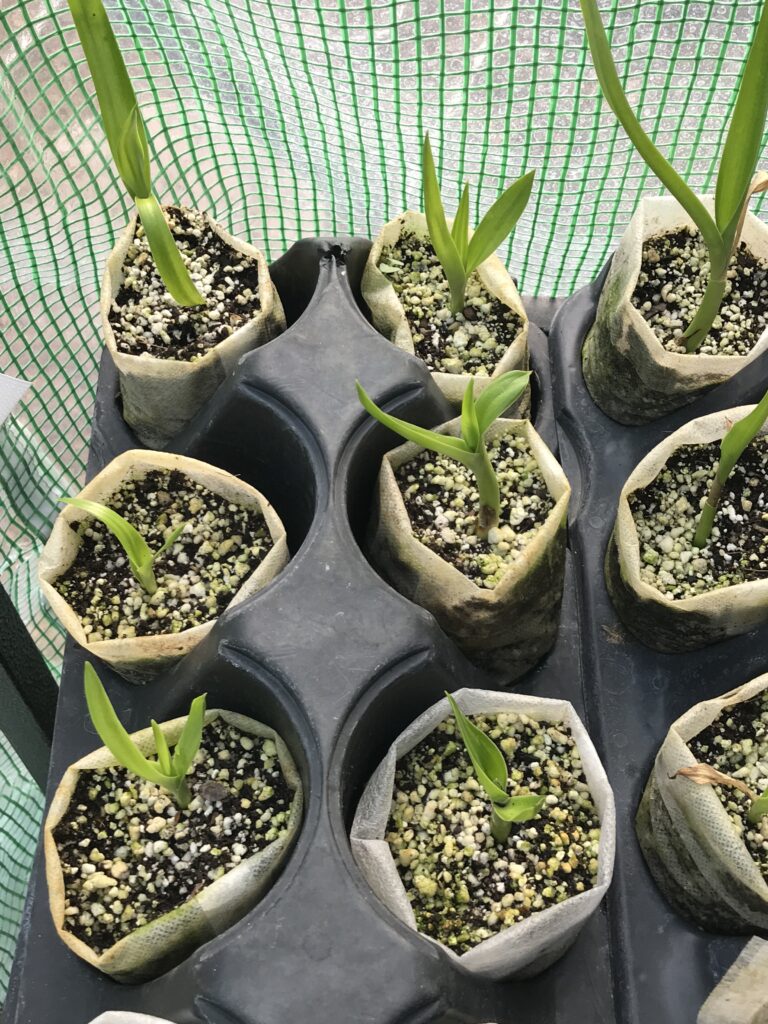
If you wish to plant your container crinums into the garden, you can do so once they have established a robust root system and the weather is conducive.
In this way, you can be sure they’re viable before transplanting them to a more permanent location in your garden or landscape. This is typically done in the spring or early summer.
Frequently Asked Questions About Crinum Lilies
This section offers quick and concise answers to some common questions about the care and cultivation of Crinum Lilies, aimed at helping gardeners of all levels.
Do hummingbirds like crinum lilies?
Absolutely! Crinum lilies are attractive to a variety of hummingbirds. Their large, trumpet-shaped flowers, particularly those with bright colors, are excellent sources of nectar. Species like the Ruby-throated Hummingbird and the Black-chinned Hummingbird, common in areas where crinum lilies grow, are often drawn to these vibrant blooms.
What pollinator insects like crinum lily?
Crinum lilies attract a range of pollinator insects, notably including various species of bees and butterflies. Bees such as the European honeybee (Apis mellifera) and native bee species frequently visit these flowers. Butterflies, including the Monarch (Danaus plexippus) and Swallowtails (Papilio spp.), are also drawn to crinum lilies for their nectar. These pollinators play a crucial role in the reproductive cycle of the plants.
Are Crinum lilies perennials?
Yes, Crinum lilies are perennials. They are known for their long-lasting nature, coming back year after year, and often increase in size and bloom capacity with each growing season.
How long do Crinum lilies live?
Crinum lilies can live for many years, often several decades, when provided with the right growing conditions. They are long-lived perennials that grow larger and more prolific with age.
How long does it take for a crinum lily to bloom?
A crinum lily typically takes two to three years to bloom when grown from a bulb. However, the time to first bloom can vary depending on factors like the age of the bulb at planting and the growing conditions. Once established, crinum lilies bloom annually, usually in the summer.
How often do crinum lilies bloom?
Crinum lilies typically bloom from spring to fall, usually in response to rainfall or adequate irrigation.
Do crinum lilies like sun or shade?
Crinum lilies prefer full sun to partial shade. They thrive in areas where they receive at least four to six hours of sunlight daily. While they can tolerate some shade, too much shade can reduce flowering. In extremely hot climates, providing some afternoon shade can be beneficial.
How deep do you plant a crinum bulb?
A crinum bulb should be planted so that the top of the bulb is just below the soil surface, usually about 3 to 4 inches deep. It’s important to ensure the bulb is planted at the correct depth to promote healthy growth and flowering.
Do crinum lilies spread?
Yes, crinum lilies can spread over time. They produce offsets or “pups” from the main bulb, which can be separated and replanted to grow new plants. They also produce bulbils at the tops of flower stems, which fall over, usually within a few feet of the parent plant. These root nearby and grow into new Crinum Lily plants.
Should I cut back Crinum Lily?
Yes, you can cut back crinum lilies, especially to remove spent flower stalks and yellowing or damaged leaves. This helps maintain the plant’s appearance and directs energy back to the bulb. However, it’s important to leave healthy foliage intact, as it continues to photosynthesize and strengthen the bulb.
Are crinum lilies hardy?
Crinum lilies are hardy in USDA zones 7 through 11. They can withstand temperatures down to about 0°F (-18°C) for short periods. However, prolonged exposure to freezing temperatures can be harmful. In colder zones, they may require mulching or overwintering indoors to protect the bulbs from harsh winter conditions.
How poisonous are crinum lilies?
Crinum lilies are considered moderately poisonous. All parts of the plant contain alkaloids that can be toxic if ingested, with symptoms ranging from nausea and vomiting to more severe reactions. It’s important to handle these plants with care and keep them away from pets and children who might ingest them.
Growing and Propagating Crinum Lily

Crinum lilies are a fascinating and diverse group of plants, offering a wealth of beauty and interest to gardeners and nature enthusiasts alike. From their stunning, fragrant blooms to their adaptability across various climates, these perennials add a unique charm to any garden setting.
While they require some basic care and attention, their resilience and ease of care make them a rewarding choice for both novice and experienced gardeners.
By understanding their needs and common issues, you can enjoy the magnificent presence of Crinum lilies in your garden for many years to come.




